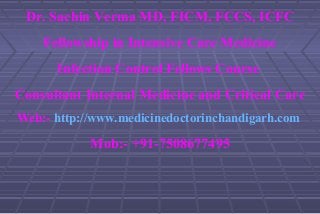
Anti tuberculosis treatment in special clinical situations
- 1. Dr. Sachin Verma MD, FICM, FCCS, ICFC Fellowship in Intensive Care Medicine Infection Control Fellows Course Consultant Internal Medicine and Critical Care Web:- http://www.medicinedoctorinchandigarh.com Mob:- +91-7508677495
- 2. Anti tuberculosis treatment in special clinical situations
- 3. Pregnancy WHO - 2HRZE+ 4HR AMERICAN THORACIC SOCIETY - 2HRE +7HR (Z is not recommended in USA due to lack of its teratogenicity data) Streptomycin is contraindicated as it causes 8th CN damage in fetus
- 4. Breast feeding No contraindication for ATT. Most of the drugs administered will be present in small quantities in breast milk, but at a concentration far to low to provide any therapeutic or prophylactic benefit to child. Prophylactic Isoniazid is given for at least 3 months beyond the time mother is noninfectious. BCG vaccination should be postponed until end of Isoniazide prophylaxis.
- 5. Oral contraception Rifampicin interacts with oral contraceptives with a risk of decreased protective efficacy against pregnancy. 2 options are there a. Use OCP containing a higher dose estrogen. b. Use another form of contraception
- 6. ATT induced hepatitis Rule out other causes of hepatitis. In drug induced hepatitis ATT should be stopped. Wait for an extra 2 week before recommencing TB treatment after jaundice has disappeared. Once drug induced hepatitis has resolved, same drugs are reintroduced one at a time.
- 7. Avoid Pyrazinamide. Preferred regimen 2SHE+10HE. In severely ill TB patient with hepatitis in whom withdrawing ATT will lead to fatal complications, patient should be treated with Streptomycin and Ethambutol. After hepatitis has resolved, usual TB treatment should be restarted.
- 8. Renal failure Aminoglycosides are contraindicated. In mild to moderate renal failure HRZ should be used, In severe renal failure, reduce the dose of Isoniazide and Pyrazinamide, except in patients with hemodialysis. Ethambutol should only be used when plasma levels can be monitored.
- 9. HIV and ATT The standard treatment is equally efficacious in HIV +ve and HIV –ve patients. 3 important considerations in patients of HIV are a. An increased frequency of paradoxical reactions b. Drug interaction between HAART and Rifampicin c. NRTIS and Isoniazid
- 10. Possible options for antiretroviral therapy in TB patients include- 1.Defer antiretroviral therapy until TB treatment is completed. 2.Defer HAART until the end of initial phase of treatment and use Isoniazide and Ethambutol. 3.Treat TB with a Rifampicin containing regimen and use Efavirenz +2NRTIS 4.Treat TB with a Rifampicin containing regimen and use 2NRTIS;then change to maximally suppressive HAART regimen on completion of TB treatment
